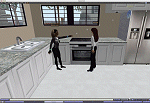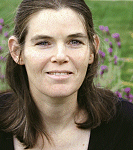CT Briefs
:: NEWS
TRAINING IN SECOND LIFE.
Tremendous cost savings, along with
the ability to offer more realistic emergency
preparedness training to a wider
audience of health care professionals
and emergency responders, are two of
the reasons behind Play2Train, a twoyear-
old effort at Idaho State University that is using tools like Second
Life to enable
distance learning for emergency
response training. The Play2Train
Open Content Alliance is an evolving
collaborative effort among universities
to build a permanent archive of open
source virtual worlds (including their
content and applications) to support
public domain emergency preparedness
training and exercises. Read
more here.

Visitors in Second Life explore sustainable housing design.
REAL AND VIRTUAL
HOUSING. Students in a
graduate-level interdisciplinary
communication course at The
University of Texas at Austin needed to produce a class project
in an authentic communication
context. They chose to create a
Second Life build of two sustainable
urban housing designs called
The Alley Flats, being piloted in
real life by The BaSiC Initiative, a UT-Austin program
focused on building sustainable
communities. Working with volunteer
expert builders in SL who used realworld
architectural drawings to construct
the virtual houses, the students
created an interactive resource where
visitors in SL can learn about sustainable
design, access plans, and find a
network of collaborating organizations.
DIGITAL MEDIA INTEGRATION.
Yale University (CT) is piloting a new
program that integrates its open source
collaboration and learning environment,
Sakai, and its
digital asset and digital rights management
system, C-Labs from Cdigix. Yale has used the
C-Labs web-based DAM/DRM tool
since 2004 to deliver online digital
media to students in about 400 courses.
The integration of the two systems
will enable viewing of media directly
from within Sakai. Read more here.
BRINGING HISTORY TO LIFE.
At The University of North Carolina
at Greensboro, Western Civilization
101 and 102 students immerse themselves
in web-based scenarios that
make history come to life. In the 101
course, they become undercover detectives
who investigate the theft of valuable
historical artifacts. In 102, they
participate in an “Artifacts Roadshow”
and appraise items with possible historical
significance. Both courses leverage
rich multimedia, including live-action
video and interactive participation.
Course developers have made creative
use of Adobe Flash,
PHP 5.0, and XML, with student information
stored in a MySQL database.
DON’T CRY FOR NYUeVITA. At
New York University, professional
staff and students collaborated on the
design, development, and branding of
the university’s ePortfolio system,
dubbed NYUeVita. As a beta school
for Symplicity,
NYU was able to play a major part in
the software development process and
customize the look and feel of the system.
NYUeVita is now pre-populated
in the NYUHome portal accounts of
all students, but users can selectively
and easily create highly customized
ePortfolios from the basic template
and uploaded data such as personal
profile, skills, documents, videos, and
references.
:: PEOPLE
 STANFORD PROF GETS
ACM-INFOSYS AWARD. Infosys
Technologies and the Association for Computing
Machinery have
presented the first ACM-Infosys
Foundation Award in the Computing
Sciences to Daphne Koller, a leading
researcher and student mentor at
Stanford University (CA). Koller’s own
research contributions
to computer
science and the
field of artificial
intelligence have
been enormous, but
her thought leadership
in the advancement of computer
science as a field of study, and
the fostering of innovation, have
also set her apart. Notably, she has
involved undergraduate students in
computer science research, expanding
their learning experiences far
beyond the textbook problem sets
that lead only to predetermined
answers. Read more here.
STANFORD PROF GETS
ACM-INFOSYS AWARD. Infosys
Technologies and the Association for Computing
Machinery have
presented the first ACM-Infosys
Foundation Award in the Computing
Sciences to Daphne Koller, a leading
researcher and student mentor at
Stanford University (CA). Koller’s own
research contributions
to computer
science and the
field of artificial
intelligence have
been enormous, but
her thought leadership
in the advancement of computer
science as a field of study, and
the fostering of innovation, have
also set her apart. Notably, she has
involved undergraduate students in
computer science research, expanding
their learning experiences far
beyond the textbook problem sets
that lead only to predetermined
answers. Read more here.